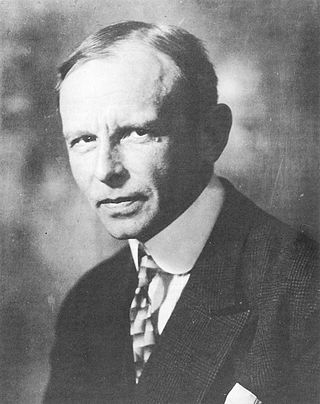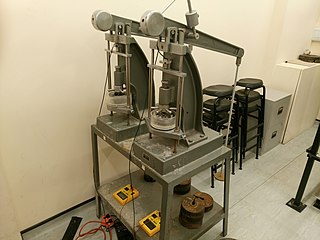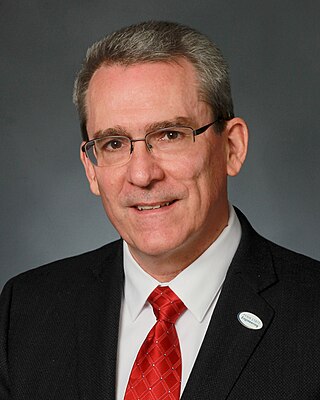Related Research Articles

Geotechnical engineering, also known as geotechnics, is the branch of civil engineering concerned with the engineering behavior of earth materials. It uses the principles of soil mechanics and rock mechanics to solve its engineering problems. It also relies on knowledge of geology, hydrology, geophysics, and other related sciences.

Karl von Terzaghi was an Austrian mechanical engineer, geotechnical engineer, and geologist known as the "father of soil mechanics and geotechnical engineering".

Soil consolidation refers to the mechanical process by which soil changes volume gradually in response to a change in pressure. This happens because soil is a three-phase material, comprising soil grains and pore fluid, usually groundwater. When soil saturated with water is subjected to an increase in pressure, the high volumetric stiffness of water compared to the soil matrix means that the water initially absorbs all the change in pressure without changing volume, creating excess pore water pressure. As water diffuses away from regions of high pressure due to seepage, the soil matrix gradually takes up the pressure change and shrinks in volume. The theoretical framework of consolidation is therefore closely related to the concept of effective stress, and hydraulic conductivity. The early theoretical modern models were proposed one century ago, according to two different approaches, by Karl Terzaghi and Paul Fillunger. The Terzaghi’s model is currently the most utilized in engineering practice and is based on the diffusion equation.
Ralph Brazelton Peck was a civil engineer specializing in soil mechanics, the author and co-author of popular soil mechanics and foundation engineering text books, and Professor Emeritus of Civil Engineering at the University of Illinois Urbana-Champaign. In 1948, together with Karl von Terzaghi, Peck published the book Soil Mechanics in Engineering Practice, an influential geotechnical engineering text which continues to be regularly cited and is now in a third edition.
Arthur Casagrande was an American civil engineer born in Austria-Hungary who made important contributions to the fields of engineering geology and geotechnical engineering during its infancy. Renowned for his ingenious designs of soil testing apparatus and fundamental research on seepage and soil liquefaction, he is also credited for developing the soil mechanics teaching programme at Harvard University during the early 1930s that has since been modelled in many universities around the world.

Ioannis Vardoulakis was an eminent scientist who is known for his major contributions in the modeling of geomaterials, geo-hazards and geotechnical processes. He was the pioneer of the bifurcation theory of geomechanics, which has led to a better understanding of the long-standing problem of mesh-dependency in the Finite Element Modeling. He also contributed to the enriched continuum modeling, which allowed for the first time the constitutive modeling of shear bands and worked extensively in experimental geomechanics, having developed ingenious devices to test geomaterials.

John Boscawen Burland is a geotechnical engineer, Emeritus Professor and Senior Research Investigator at the Department of Civil and Environmental Engineering of Imperial College London, and a noted expert in the field of soil mechanics.

The Department of Civil and Environmental Engineering is the academic department at Imperial College London dedicated to civil engineering. It is located at the South Kensington Campus in London, along Imperial College Road. The department is currently a part of the college's Faculty of Engineering, which was formed in 2001 when Imperial College restructured. The department has consistently ranked within the top five on the QS World University Rankings in recent years.

Andrew Noel Schofield is a British soil mechanics engineer and an emeritus professor of geotechnical engineering at the University of Cambridge.

Lyesse Laloui, is a Swiss engineer and Professor at EPFL, École Polytechnique Fédérale de Lausanne. He is Chair full Professor of Soil Mechanics, Geo-Engineering and CO2 Storage at EPFL's School of Architecture, Civil and Environmental Engineering and is the Director of the Soil Mechanics Laboratory.
Harry George Poulos is an Australian of Greek descent civil engineer specialising in geotechnical engineering and soil mechanics, internationally known as an expert on soil behaviour and pile foundations.

Dame Sarah Marcella Springman is a British-Swiss triathlete, civil engineer, and academic. She was educated in England and spent much of her career in Switzerland. She is a former rector of the Swiss Federal Institute of Technology in Zurich and currently Principal of St Hilda's College at the University of Oxford.

J. Carlos Santamarina is a professor of Civil and Environmental Engineering and Clough Chair at the Georgia Institute of Technology, Atlanta, USA.

Alexander M. Puzrin is professor of geotechnical engineering at ETH Zurich, Switzerland, working in the field of geomechanics.
Thomas William Lambe was an American geotechnical engineer and an emeritus professor at the Massachusetts Institute of Technology.
Franz-Josef Ulm is a structural engineer, an engineering scientist and a professor since 1999. He is Professor of Civil & Environmental Engineering at the Massachusetts Institute of Technology (MIT), the Faculty Director of the Concrete Sustainability Hub (CSHub@MIT). He is credited for discovering the nanogranular structure of calcium silicate hydrates (C-S-H), the binding phase of concrete, and for the development of concepts of nanoengineering of concrete which combine advanced nanomechanics experiments with molecular simulation results. He advocates for environmentally sustainable engineering, with "greener" concrete with lower CO2 footprint, to reduce the carbon footprint of concrete; to enhance concrete's resilience; and reduce its impact on global warming.
David Muir Wood is an academic working in the field of geomechanics and soil mechanics, famous for having pioneered advances in mathematical modelling of soils, informed by experimental observation. The hallmark of his modelling efforts has been to formulate elegant models that capture the essence of the material response while being accessible to practitioners of Geotechnical engineering.

Patrick J Fox, Ph.D., P.E., BC.GE, F.ASCE is an American civil engineer and currently the Dean of the Russ College of Engineering and Technology at Ohio University. His field of expertise is geotechnical and geoenvironmental engineering, with specializations in slope stability, retaining walls, landfills, and settlement. He obtained a Ph.D. in civil and environmental engineering from the University of Wisconsin–Madison in 1992.
Catherine O'Sullivan is an Irish environmental engineer who is Professor of Particulate Soil Mechanics and Head of the Geotechnics Section at Imperial College London. She uses discrete element modelling to understand fundamental processes in sand and soils.
Izzat M. Idriss (1935-) is a Syrian-American geotechnical engineer. His research on the geotechnical aspects of earthquake engineering has led to the development of many of the currently used procedures for evaluating the behavior of soil sites and soil structures during earthquakes, such as methods for evaluating: the characteristics of earthquake ground motions; seismic response of sites; potential for soil liquefaction; performance of embankment dams during earthquakes; and soil-structure interaction in response to earthquake shaking.
References
- ↑ Whittle, A. J.; Kavvadas, M. J. (1994). "Formulation of MIT‐E3 Constitutive Model for Overconsolidated Clays". Journal of Geotechnical Engineering. 120: 173–198. doi:10.1061/(ASCE)0733-9410(1994)120:1(173).
- ↑ Edmund K. Turner Professor Andrew J. Whittle
- ↑ MIT News - "Professor Andrew Whittle to head Department of Civil and Environmental Engineering"
- ↑ Professor Andrew J. Whittle's Research Group (http://ajw-group.mit.edu)
- ↑ Whittle, A. J. (1987) A constitutive model for overconsolidated clays with application to the cyclic loading of friction piles. ScD Thesis, Massachusetts Institute of Technology.
- ↑ Whittle, A. J.; Kavvadas, M. J. (1994). "Formulation of MIT‐E3 Constitutive Model for Overconsolidated Clays". Journal of Geotechnical Engineering. 120: 173–198. doi:10.1061/(ASCE)0733-9410(1994)120:1(173).
- ↑ Andrew Whittle to head Department of Civil and Environmental Engineering – MITnews
- ↑ International Journal for Numerical and Analytical Methods in Geomechanics
- ↑ The list of publications
- ↑ "Karl Terzaghi Lecture". www.asce.org. Retrieved 28 February 2024.